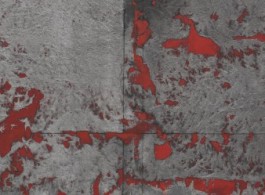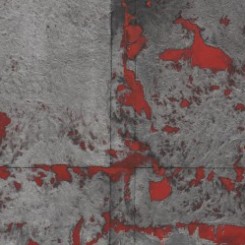CHUNG CHANG-SUP “MEDITATION”
Galerie Perrotin, Hong Kong
November 3 – December 21, 2016
Galerie Perrotin, Hong Kong is pleased to present “Meditation”, the gallery’s third exhibition dedicated to the late Dansaekhwa master Chung Chang-Sup. The artist’s premier solo exhibition in Hong Kong will center around his renowned Meditation series, with a particular focus on his experimental and mature works that epitomize his corpus.
The ethos of Chung Chang-Sup’s oeuvre, in the spirit of Dansaekhwa, lies not in the finished product but a long, arduous production process that is characterized by the repetition of gestures and rumination over the materials. This ritualistic procedure necessitates a full immersion of the self, with the absence of preconceived plans and clear end points. The work is only deemed complete when the union between mind and matter is attained. Chung’s creation, alive with the artist’s魂 (transliterated as hon), meaning spirit or soul, exemplifies his lifelong devotion to achieving oneness with nature.
Hanji, the traditional handmade Korean paper, sits at the fulcrum of Chung’s artistic endeavor. The rediscovery of hanji in the 1970s brought on a career Renaissance for the artist; at last Chung felt a sense of unity with his works, a sentiment he lacked as an oil painter. Chung’s strong affinity towards hanji originates from his childhood during which he spent living in a hanok, a traditional Korean house, where window and door panes were covered with hanji. The breathability of the hanji allowed for the young Chung to witness the passage of time, fleeting lights, and the changing seasons from inside his home. Thus, the multi-sensory experience of nature’s wonders was a constant during his formative years, making his regression back to hanji during his 40s a natural, almost inevitable, shift.
The hanji that appears in Chung’s corpus is not the traditional kind that we are familiar with. Known as the tak (mulberry bark) paper, Chung’s self-produced sheets retain more of the natural fibers of tak, the raw material of hanji. The novelty of Chung’s usage of tak paper lies in endowing more agency and autonomy to the material; historically, hanji had been merely used as a support on top of which art was created. By making literal the raw fibers of tak, Chung has elevated this marginalized material to the star status in his abstract creations. In addition, Chung has enlivened and modernized a Korean tradition, transforming it into a lexicon that can be understood by an international community yet is inherently Korean.
The full possibilities of the tak paper are exploited in the Meditation series, which spanned from the early 1990s until the artist’s passing in 2011. Chung brought the heightened materiality of tak to the forefront by massaging, kneading and battering the wet tak pulp, mulling over the material over a long period of time before applying it on top of the canvas. The rigid separation between the flattened square bed of the center and the margins that embrace the architectural persona of the tak further accentuate the tactility and spirituality of the material, in addition to enticing the viewer’s optical senses. It serves as a visual reminder of the tak paper’s ability to breathe in and out, internalize the external and externalize the internal. Thus, tak paper takes on a dual role in Chung’s works—for Chung, it served as a window out into the world, but for the viewers, it serves as a window into the artist’s soul.
Before the visual vocabulary of the Meditation series was solidified, there was a short experimental phase during the early days of the series where he infused vibrant, vivid colors to his paper. This departure from the neutral tones that typify Chung’s oeuvre is not unprecedented however. During his investigation into mixing oil paint with Eastern ink painting technique in the late 1960s, Chung temporarily broke away from his much established monochromatic palette by introducing a bold color scheme consisting of primary colors.
The zenith of Chung’s experimental phase with colors is marked by the two six-paneled canvases in ultramarine blue and vermillion red hung on the Gallery’s main wall. Chung had regarded these works as failed attempts and kept them hidden during his lifetime. It was not until last year at his second solo exhibition with Galerie Perrotin in New York that the blue piece was shown to the public for the first time. While he may have felt ashamed of steering away from the sense of self-control and restraint that pervade his other works, these experimental works could be interpreted as an alternative culmination to his meditative ritual. These vivacious colors should not be understood in accordance with the physicality of the pigment nor in the Western notion of color, but as a corporeal manifestation of the artist’s psyche. Imbued with psychological depth, they are the residues found in their purest, most untainted state at the end of his arduous meditation involving endless filtering and sifting or shifting of the mind. Standing in contrast to the Meditation’s mature works, these experimental pieces legitimize the multivalent nature of the series and help to further expand our understanding of Chung’s artistic realm.
Born in 1927 in Cheongiu, Korea, Chung Chang-Sup received his BFA in Painting from the College of Fine Arts, Seoul National University in 1951. He passed away in 2011.
Chung’s work was the subject of a major retrospective at the National Museum of Contemporary Art, Gwacheon, Korea in 2010. His work has also been included in major Dansaekhwa exhibitions around the world, including “Dansaekhwa” at Villa Empain, Brussels, Belgium (2016); “Dansaekhwa” at Palazzo Contarini-Polignac, Venice (2015); “The past, the present, the possible” at Sharjah Biennial 12 (2015); and “The Art of Dansaekhwa” at Kukje Gallery, Seoul (2014).
Chung’s work is included in the permanent collections of major museums, including National Museum of Contemporary Art, Gwacheon, Korea; Leeum, Samsung Museum of Art, Seoul, Korea; Seoul Museum of Art, Seoul, Korea; Busan Museum of Modern Art, Busan, Korea; Daejeon Museum of Art, Daejeon, Korea; Royal Nepal Museum, Nepal; Tokyo Metropolitan Art Museum, Tokyo, Japan; Mie Prefectural Art Museum, Mie, Japan; Shimonoseki City Art Museum, Shimonoseki, Japan; Hiroshima City Museum of Contemporary Art, Hiroshima, Japan; M+ Museum for Visual Culture, Hong Kong; and the Guggenheim Abu Dhabi, Abu Dhabi, UAE.


